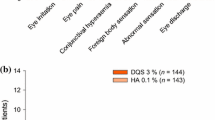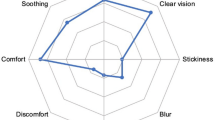Abstract
Cationorm® is a unique preservative-free option for the treatment of the symptoms of dry eye that offers some advantages over conventional artificial tears. The electrostatic interaction between the positively charged Cationorm® emulsion and the negatively charged cells on the ocular surface prolongs the residence time on the ocular surface. Moreover, as an oily emulsion, Cationorm® augments all three layers of tear film (i.e. lipid layer, aqueous coating and mucin layer), thereby stabilizing the tear film and providing beneficial moisturizing and lubricating effects. Overall, the efficacy and tolerability/safety profiles of Cationorm® in treating mild to severe dry eye disease in clinical trials are similar to, or better than, those of other artificial tears.
Similar content being viewed by others
References
Marshall LL, Roach JM. Treatment of dry eye disease. Consult Pharm. 2016;31(2):96–106.
Fiscella RG. Understanding dry eye disease: a managed care perspective. Am J Manag Care. 2011;17(Suppl 16):S432–9.
The definition and classification of dry eye disease. report of the Definition and Classification Subcommittee of the International Dry Eye WorkShop (2007). Ocul Surf. 2007;5(2):75–92.
The epidemiology of dry eye disease: report of the Epidemiology Subcommittee of the International Dry Eye WorkShop (2007). Ocul Surf. 2007;5(2):93–107.
Foulks GN. Pharmacological management of dry eye in the elderly patient. Drugs Aging. 2008;25(2):105–18.
Friedman NJ. Impact of dry eye disease and treatment on quality of life. Curr Opin Ophthalmol. 2010;21(4):310–6.
Nichols KK, Foulks GN, Bron AJ, et al. The International Workshop on meibomian gland dysfunction: executive summary. Invest Ophthalmol Vis Sci. 2011;52(4):1922–9.
Lemp MA, Crews LA, Bron AJ, et al. Distribution of aqueous-deficient and evaporative dry eye in a clinic-based patient cohort: a retrospective study. Cornea. 2012;31(5):472–8.
Skalicky SE, Petsoglou C, Gurbaxani A, et al. New agents for treating dry eye syndrome. Curr Allergy Asthma Rep. 2013;13(3):322–8.
Lienart JP, Tarko L, Uchino M, et al. Long-term natural history of dry eye disease from the patient’s perspective. Ophthalmology. 2016;123(2):425–33.
Tong L, Petznick A, Lee S, et al. Choice of artificial tear formulation for patients with dry eye: where do we start? Cornea. 2012;31(Suppl 1):S32–6.
Georgiev GA, Yokoi N, Ivanova S, et al. Surface chemistry of the interactions of cationic nanoemulsions with human meibum films [poster]. In: The Annual meeting of the Association for Research in Vision and Ophthalmology; 2016.
Cationorm eye drop emulsion: patient information [in German]. Munich: Santen GmbH; 2013.
Lallemand F, Daull P, Benita S, et al. Successfully improving ocular drug delivery using the cationic nanoemulsion, Novasorb. J Drug Del. 2012;2012:604204. doi:10.1155/2012/604204.
Daull P, Lallemand F, Garrigue JS. Benefits of cetalkonium chloride cationic oil-in-water nanoemulsions for topical ophthalmic drug delivery. J Pharm Pharmacol. 2014;66(4):531–41.
Daull P, Feraille L, Elena PP, et al. Comparison of the anti-inflammatory effects of artificial tears in a rat model of corneal scraping. J Ocul Pharmacol Ther. 2016;32(2):109–18.
Kinnunen K, Kauppinen A, Piippo N, et al. Cationorm shows good tolerability on human HCE-2 corneal epithelial cell cultures. Exp Eye Res. 2014;120:82–9.
Binlich F, Baudouin C, Pisella PJ, et al. A noval cationic emulsion, Cationorm, for treatment of patients with bilateral moderate dry eye syndrome [abstract]. Invest Ophthalmol Vis Sci. 2006;47(13):254.
Amrane M, Creuzot-Garcher C, Robert PY, et al. Ocular tolerability and efficacy of a cationic emulsion in patients with mild to moderate dry eye disease: a randomised comparative study. J Fr Ophtalmol. 2014;37(8):589–98.
Aragona P, Spinella R, Rania L, et al. Assessment of the efficacy of Cationorm® in patients with moderate dry eye compared with Optive® and Emustil® eye drops [abstract no. 3125]. Acta Ophthalmologica. 2011;89(Suppl s248).
Ismail D, Amrane M, Robert P-Y, et al. Efficacy of Cationorm® preservative-free cationic emulstion versus Vismed® (0.18% hyaluronic acid) in mdoerate to severe dry eye disease (DED) patients [slide presentation]. Evry, France: Santen SAS; 2016.
du Toit LC, Pillay V, Choonara YE, et al. Ocular drug delivery: a look toward nanobioadhesives. Expert Opin Drug Del. 2011;8(1):71–94.
Management and therapy of dry eye disease: report of the Management and Therapy Subcommittee of the International Dry Eye WorkShop (2007). Ocul Surf. 2007;5(2):163–78.
Acknowledgments
The manuscript was reviewed by R. G. Fiscella, Department of Pharmacy Practice, University of Illinois at Chicago, Chicago, IL, USA. During the peer review process, the manufacturer of Cationorm® was offered an opportunity to comment on the article. Changes resulting from comments received were made by the author on the basis of scientific and editorial merit.
Author information
Authors and Affiliations
Corresponding author
Ethics declarations
Funding
The preparation of this review was not supported by any external funding.
Conflict of interest
K. A. Lyseng-Williamson is a salaried employee of Adis/Springer, is responsible for the article content and declares no conflicts of interest.
Rights and permissions
About this article
Cite this article
Lyseng-Williamson, K.A. Cationorm® (cationic emulsion eye drops) in dry eye disease: a guide to its use. Drugs Ther Perspect 32, 317–322 (2016). https://doi.org/10.1007/s40267-016-0319-0
Published:
Issue Date:
DOI: https://doi.org/10.1007/s40267-016-0319-0




